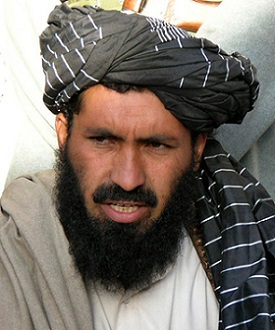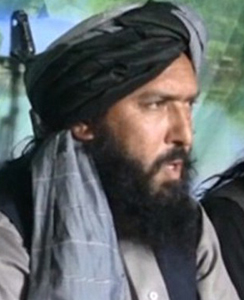
The Utmanzai or Utmanzai Wazir (trans. "descendants of Utman", [1] and also spelled Uthmanzai, Othmanzai) are a Sunni Muslim Pashtun tribe found in North Waziristan Agency, and Bannu Subdivision Wazir.

The Utmanzai or Utmanzai Wazir (trans. "descendants of Utman", [1] and also spelled Uthmanzai, Othmanzai) are a Sunni Muslim Pashtun tribe found in North Waziristan Agency, and Bannu Subdivision Wazir.
Their territory lies on the border with Afghanistan and historically they migrated between the hills during the summer and the valleys in the winter. Although primarily a pastoral tribe, they and the related Mehsud tribe — with whom they have a historical antipathy — were described by Arnold Fletcher in 1965 as "perhaps the most powerful and aggressive of the border Pushtoons". [2] [3]
The Utmanzai form one of the two major branches of the Wazir tribe, with the other being the Ahmadzai of South Waziristan Agency. [4] [5] The Utmanzai branch is further subdivided, for example into tribes such as the Bakka Khel and Jani Khel. [6] The common ancestor of the Ahmadzai and Utmanzai is the eponymous Wazir, who is also ancestor to the Mehsuds who have since taken a distinct and divergent path. Through Wazir, the tribes trace their origins to Karlanri and thence to the founder of the Pashtun lineage, Qais Abdur Rashid. [1] The North and South Waziristan agencies together form the region of Waziristan, which derives its name from this supra-tribe. [7]
In December 2012, the government of North Waziristan Agency used its powers under the Frontier Crimes Regulations to remove privileges from the Utmanzai, such as honorariums given to tribal elders. The government also ordered that the issue of official documentation, such as national identity cards and passports, to members of the tribe should cease. These measures were taken in an attempt to force members of the tribe to provide security for teams who were running a polio vaccination campaign in the area. The Shura Mujahideen, led by Hafiz Gul Bahadur — a member of the tribe and a militant leader associated with Tehrik-i-Taliban Pakistan [8] — had issued an order in June 2012 that the campaign should be opposed until drone attacks by the United States ended. Tribal members also believed that the US took advantage of vaccination campaigns for intelligence purposes and that it was a fake vaccination campaign in Abbottabad that had led to the tracing of the Al-Qaeda leader, Osama bin Laden. [9] The restrictions were lifted temporarily in February 2013 to allow voter registration to be completed. [10]
Waziristan is a mountainous region covering the North Waziristan and South Waziristan districts of the Pakistani province of Khyber Pakhtunkhwa. Waziristan covers around 11,585 square kilometres (4,500 sq mi) and is mainly populated by the Wazir Pashtun tribe, who speak the Waziri dialect of the Pashto language.

North Waziristan District is a district of Khyber Pakhtunkhwa province in Pakistan. It is the northern part of Waziristan, a mountainous region of northwest Pakistan, bordering Afghanistan and covering 4,707 square kilometres (1,817 sq mi). The capital city of North Waziristan is Miranshah.

Wāṇa or Wanna is the largest town in the South Waziristan District of the Khyber Pakhtunkhwa province of Pakistan. It is the summer headquarters for the agency's administration, Tank located in the neighbouring Tank District being the winter headquarters.

Aḥmadzai is a Sunni Muslim Pashtun tribe found in South Waziristan and Bannu District in the Federally Administered Tribal Areas of Pakistan. They are a clan of the larger Wazir tribe.

South Waziristan District was a district in the Dera Ismail Khan Division of the Khyber Pakhtunkhwa province before splitting into the Lower South Waziristan District and the Upper South Waziristan District on April 13, 2022. It covers around 11,585 km2 (4,473 mi2). Waziristan is located in the southwest of Khyber Pakhtunkhwa. It is situated between two rivers. The Tochi River is flowing on its north and the Gomal River is flowing on its south. The region was an independent tribal territory from 1893, separated from both Afghanistan the British-ruled empire in the subcontinent. Raiding the tribal areas was a constant problem for the British, requiring frequent punitive expeditions between 1860 and 1945. Troops of the British Raj coined a name for this region "Hell's Door Knocker" in recognition of the fearsome reputation of the local fighters and inhospitable terrain. The district headquarter of the South Waziristan district is Wanna. South Waziristan is divided into three administrative subdivisions of Ladha, Sarwakai, and Wanna. These three subdivisions are further divided into eight Tehsils: Ladha, Makin, Sararogha, Sarwakai, Tiarza, Wanna, Barmal, and Toi Khula.
The Mahsud is a Karlani Pashtun tribe inhabiting mostly the South Waziristan Agency in Khyber Pakhtunkhwa province of Pakistan.

Baitullah Mehsud was one of the founders and a leading member of the TTP in Waziristan, Pakistan, and the leader of the Tehrik-e-Taliban Pakistan (TTP). He formed the TTP from an alliance of about five militant groups in December 2007. He is thought by U.S. military analysts to have commanded up to 5,000 fighters and to have been behind numerous attacks in Pakistan including the assassination of Benazir Bhutto which he and others have denied.
The Wazirs or Waziris are a Karlani Pashtun tribe found mainly in the Pakistan-Afghanistan border region. The Utmanzai Wazir are settled in the North Waziristan and Bannu Subdivision Wazir and the Ahmadzai Wazir are in the South Waziristan, and in Domel, Bannu. Those subgroups are in turn divided further, for example into Utmanzai tribes such as the Baka Khel and Jani Khel. The Wazirs speak the Waziristani dialect of Pashto which is similar to the neighboring Banuchi and Dawari dialect but still distinct.

Mir Ali or Mirali is a town in North Waziristan District, in Pakistan's Khyber Pakhtunkhwa province. Mirali is located in the Tochi Valley, about 12 kilometres (7.5 mi) east of Miramshah, 40 kilometres (25 mi) west of Bannu, Khyber Pakhtunkhwa, and 70 kilometres (43 mi) southeast of the city of Khost, Afghanistan. Mirali is at an altitude of 674 metres (2,211 ft).

Qari Zainuddin Mehsud, commonly known as Qari Zain, was a citizen of Pakistan, a member of the Mehsud tribe, and a leader of the Tehrik-i-Taliban Pakistan in South Waziristan, one of Pakistan's Federally Administered Tribal Areas. Pakistan's Daily Times described him as the "self-appointed successor of Taliban commander Abdullah Mehsud" although he feuded with Baitullah Mehsud over leadership of the Pakistani Taliban. In the months before his assassination, the Pakistani government unofficially supported Zainuddin as a counter to Baitullah.

Maulvi Nazir was a leading militant of the Pakistani Taliban in South Waziristan. Nazir's operations were based in Wana.

Hakimullah Mehsud, born Jamshed Mehsud and also known as Zulfiqar Mehsud, was a Pakistani militant who was the second emir of Tehrik-i-Taliban Pakistan, elected to the post on 22 August 2009. It was confirmed by TTP that he was killed in a U.S. drone strike in Pakistan on 1 November 2013.

The Operation Rah-e-Nijat was a strategic offensive military operation by the unified command of Pakistan Armed Forces against the Tehrik-i-Taliban Pakistan (TTP) and their extremist allies in the South Waziristan area of the Federally Administered Tribal Areas that began on June 19, 2009; a major ground-air offensive was subsequently launched on October 17. It became the integral part of the war in Western fronts which led to the encirclement and destruction of Taliban forces in the region, although the Taliban leadership escaped to lawless areas of neighboring Afghanistan.
Hafiz Gul Bahadur is the leader of a Pakistani Taliban faction based in North Waziristan. Upon the formation of the Tehrik-i-Taliban Pakistan (TTP) in December 2007, he was announced as the militant group's overall naib amir under Baitullah Mehsud, who was based in South Waziristan, but has largely distanced himself from the TTP due to rivalries with Mehsud and disagreements about the TTP's attacks against the Pakistani state.

Makeen or Makin (ماکین) is a city in the South Waziristan region of Khyber Pakhtunkhwa, Pakistan. It is located on the boundary of the North Waziristan district. On its west, it shares a border of 40 Km with Afghanistan's Barmal District and Paktika.
The Datta Khel airstrike was an American airstrike carried out on 17 March 2011 in Datta Khel, North Waziristan that killed 44 people and led to widespread condemnation in Pakistan. Sherabat Khan Wazir, a top commander of Hafiz Gul Bahadur's Taliban faction, was killed in the strike, and in response Bahadur threatened to end the peace deal struck with the Pakistani government almost four years earlier. The airstrike was part of a long series of drone attacks in Pakistan carried out by the CIA and United States military. It occurred just two days after diyya, a form of compensation paid to a victim's family under Islamic law, was paid for the release of U.S. CIA operative Raymond Allen Davis, signaling a resumption of U.S. activity after a several week hiatus while Davis' pardon on murder charges was being negotiated.
The Darweshkhel is a section of the Wazir Pashtun tribe found in South Waziristan, North Waziristan, and Frontier Region Bannu in the Federally Administered Tribal Areas of Pakistan on its border with Afghanistan.

Hafiz Saeed Khan, also known as Mullah Saeed Orakzai, Shaykh Hafidh Sa'id Khan, or Maulvi Saeed Khan, was an Islamic militant and emir for the Islamic State – Khorasan Province (ISIS–K) from January 2015 until his death in July 2016. Prior to 2015, Khan fought with the Afghan Taliban against NATO forces in Afghanistan, joined the Islamic militant group Tehrik-e Taliban Pakistan (TTP) as a senior commander, and later swore allegiance to ISIS caliph Abu Bakr al-Baghdadi, established ISIS–K in Afghanistan as the province's first emir until his death in an American strike.

Muhammad Ali Wazir is a Pakistani politician who is the co-founder of a human rights movement, Pashtun Tahafuz Movement (PTM). He had been a member of the National Assembly of Pakistan from August 2018 till August 2023. During his student life, he was active in the Pashtun Students Federation (PSF), an allied wing of the Awami National Party (ANP).